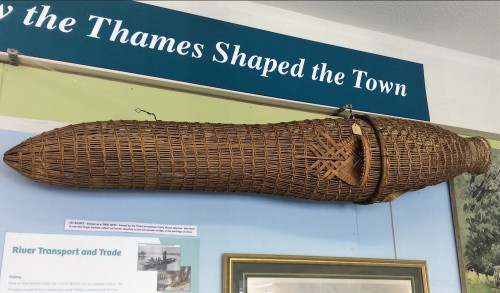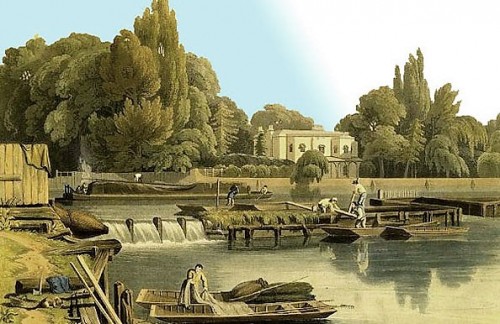


![]() This page is regularly updated, please select here to view the latest version.
This page is regularly updated, please select here to view the latest version.
A Grig Weel

Eel traps were once seen in rivers everywhere, from prehistoric times until the early 20th century. They came in two forms - grig weels like the one above, which were used by fishermen going on to the river in boats or in a mill stream where the miller could make a side profit from the catch; and eel bucks, a much larger type of trap which were usually fixed below bridges or on wooden frameworks fixed in the river. Small eels used to be known as ‘grigs’, and ‘weel’ was also used for any deep pool or eddy in a river, which is the sort of place where eels might be found. A ‘buck’ referred to any large basket - laundry baskets in particular. At one time, eel traps were such a common sight on rivers that laws had to be passed to limit their numbers. Marlow’s entry in the Domesday Book said the river here yielded 1000 eels a year.
In the picture of Marlow in the 18th century, below, you can see both types of trap. This is a view from near The Compleat Angler, with the house Thames Lawn in the background, and a glimpse of the old wooden bridge on the left, that used to cross from beside the Angler to the end of St Peter Street. The water level in the river was lower then. In one of the punts in the foreground, you can see a pile of grig weels and on the middle left you can see an eel buck jutting out from the bridge. They could be lowered to catch the eels and raised to retrieve them.

The whole business of building eel traps was tied up with the ancient system of osier cutting. 'Osier' refers to the various types of willow which were useful for basket making. There was an osiery near Marlow at Bondig Bank, a stretch of river bank opposite Bisham Abbey, named after the Saxon Bondi who was lord at Bisham before 1066. The monks at Bisham Abbey managed this bank as an osiery, where the willow branches were cut and used for baskets, fish traps, fences and hurdles.
'The willow was cut green and oozing sap, carefully split into three with a wooden tool called a clove, softened by repeatedly pulling it backwards and forwards around a table leg and then woven around a dozen or more vertical 'splits' of willow; stringers that act as formers for the body of the trap and which were propped up on a grooved wooden cone.'
Grigs were placed on the river bottom at dusk with the mouths facing downstream, and weighted with a flat stone at either end, the idea being to catch small eels on their way upstream with a bait of gudgeons. The standard method of fishing them out was to use a boathook, which made retrieving them a bit hazardous. When the trap was lifted, the owner held a sack over the ‘downstream’ end, released the bung, and poured his catch out - as easy as that.
Unlike grigs, the mouths of bucks faced upstream, because they were used to catch migrating adult eels. Bucks mounted on stages were the largest sort of eel traps made, most of them fully nine or ten feet long. On a good night the take from a team of six bucks would be more than 25 kilos. Below is a stage of five bucks at Harleyford in Victorian times.

With thanks to
www.fishingmuseum.org.uk/eel_bucks.html
www.riverthamessociety.org.uk/bondigbank.aspx
explorion.net/naturalist-thames/eel-traps
- Objects in Focus 08 -
![]()
![]()
![]()
Find Us:

Opening Times:
Mar-Oct
Saturdays 13:00 - 17:00
Sundays 13:00 - 17:00
Wednesdays 14:00 - 17:00
Nov-Feb
Sundays 14:00 - 16:00
Marlow Museum,
by entrance to Court Garden Leisure Centre,
Pound Lane, Marlow,
Buckinghamshire,
SL7 2AE.
Raise money for Marlow Museum when you shop online. .. read more
£ Grants / Funding
Thank you to these organisations
Become a Friend and/or Member of Marlow Museum. .. read more

Website Contents
(for most small images - select image to enlarge)
![]()